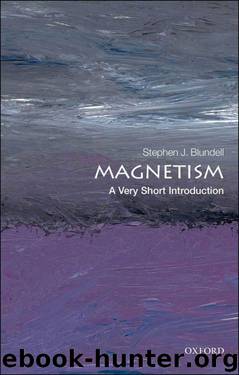Magnetism: A Very Short Introduction (Very Short Introductions) by Blundell Stephen J

Author:Blundell, Stephen J. [Blundell, Stephen J.]
Language: eng
Format: epub, azw3
Publisher: Oxford University Press
Published: 2012-06-27T21:00:00+00:00
Understanding real materials
In the 1920s and 1930s, physicists took up the challenge to apply the new quantum mechanics to magnetism, finding that the magnetic properties of many real materials could be explained by quantum mechanics. For example, it is known that most real substances are weakly diamagnetic, meaning that when placed in a magnetic field they become weakly magnetic in the opposite direction to the field. Water does this, and since animals are mostly water, it applies to them. This is the basis of Andre Geim’s levitating frog experiment: a live frog is placed in a strong magnetic field and because of its diamagnetism it becomes weakly magnetic. In the experiment, a non-uniformity of the magnetic field induces a force on the frog’s induced magnetism and, hey presto, the frog levitates in mid-air. A frog was chosen for this experiment because it was small enough to fit into the magnet, but with a big enough magnet it would in principle be possible to make pigs fly! Quantum mechanics nicely explains diamagnetism, and also the related phenomenon of paramagnetism in which a material becomes magnetic in the same direction of the magnetic field applied to it. Crystals of copper sulphate (the bright blue crystals that children often grow at school) are good examples of paramagnets.
However, the really exciting problem to get one’s head around is ferromagnetism, the magnetism of lodestone. It is a much larger effect and proved more resistant to analysis. The solution came from thinking about a very odd symmetry of quantum mechanics. Quantum mechanics states that the fundamental description of a quantum object, such as an electron, or a set of electrons, is controlled by a special mathematical function called the wave function. The wave function varies in space, and the magnitude of the square of this function at a particular place gives you the probability that the quantum object is found there.
Now take two identical particles located at two different places in space, and swap them. What you have produced has to be the same as you started with, doesn’t it? The two particles are absolutely identical and so the situation you’ve ended up with must be the same as you started with. We now know that for some of the particles in the Universe (known as bosons), this is completely true. However, for the other particles in the Universe (known as fermions), something rather special happens: the quantum mechanical wave function describing the two particles changes sign. This seems very strange, but physical reality only depends on the square of the wave function and so reality is not affected by this sign change. But the change of sign is there and does have consequences.
Electrons are fermions and so they do this sign-change trick when you swap them around. Let’s think about a piece of iron and focus in on two iron atoms inside that piece. Think about two electrons, one associated with a particular iron atom and another associated with a neighbouring iron atom. We want to consider the wave function describing those two electrons.
Download
Magnetism: A Very Short Introduction (Very Short Introductions) by Blundell Stephen J.azw3
This site does not store any files on its server. We only index and link to content provided by other sites. Please contact the content providers to delete copyright contents if any and email us, we'll remove relevant links or contents immediately.
| Electricity | Magnetism |
The Complete Stick Figure Physics Tutorials by Allen Sarah(7338)
Secrets of Antigravity Propulsion: Tesla, UFOs, and Classified Aerospace Technology by Ph.D. Paul A. Laviolette(5333)
Thing Explainer by Randall Munroe(3910)
The River of Consciousness by Oliver Sacks(3572)
The Order of Time by Carlo Rovelli(3162)
How To by Randall Munroe(3074)
A Brief History of Time by Stephen Hawking(2992)
I Live in the Future & Here's How It Works by Nick Bilton(2960)
What If?: Serious Scientific Answers to Absurd Hypothetical Questions by Randall Munroe(2670)
The Great Unknown by Marcus du Sautoy(2663)
Midnight in Chernobyl by Adam Higginbotham(2516)
Blockchain: Ultimate Step By Step Guide To Understanding Blockchain Technology, Bitcoin Creation, and the future of Money (Novice to Expert) by Keizer Söze(2467)
Networks: An Introduction by Newman Mark(2382)
The Meaning of it All by Richard Feynman(2319)
Easy Electronics by Charles Platt(2308)
The Tao of Physics by Fritjof Capra(2247)
Midnight in Chernobyl: The Untold Story of the World's Greatest Nuclear Disaster by Adam Higginbotham(2196)
When by Daniel H Pink(2098)
Introducing Relativity by Bruce Bassett(2097)
